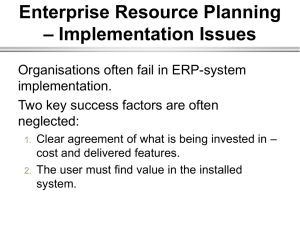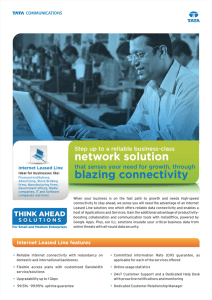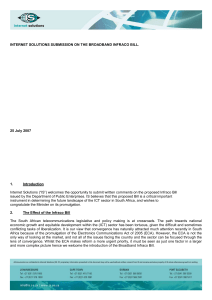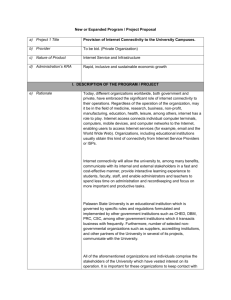Telkom Presentation
advertisement
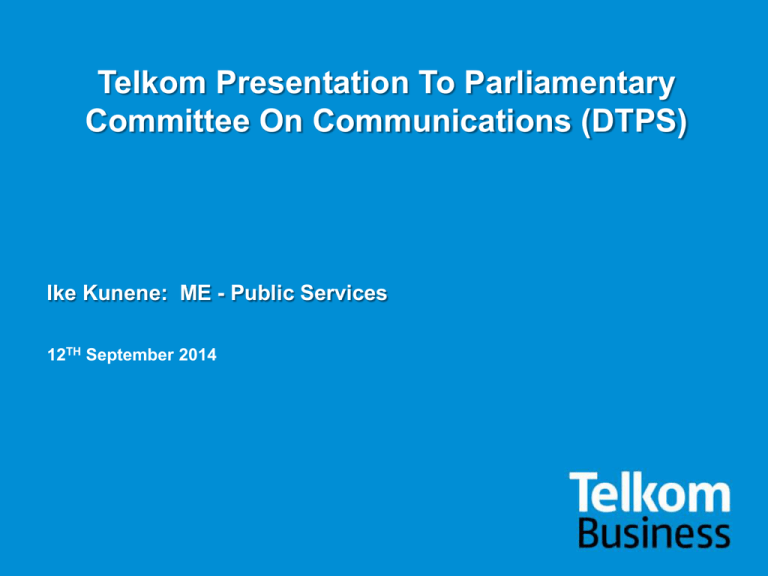
Telkom Presentation To Parliamentary Committee On Communications (DTPS) Ike Kunene: ME - Public Services 12TH September 2014 Opening remarks South Africa Connect Broadband Policy is the roadmap on SA broadband implementation hence a presentation on schools connectivity has to have regard to the Policy’s Strategic intent, aspiration and targets. Broadband Value Chain Networks Services Devices Applications Content Strategy Policy, Legal & Regulatory (institutional) framework Digital Readiness •Coordinated and integrated action on network builds •Removal of administrative and regulatory bottlenecks (rights of way) * Enforcement of wholesale access regulation * Rationalisation of state-owned companies * Appointment of Broadband Council Connected Government •Aggregation of public sector demand * Health and education connectivity priority Digital •Infrastructure extensions Development National Broadband Network •Affordable, high speed broadband •Universal coverage through multiple delivery modes Digital Future •Open access wholesale network Skills development Digital Opportunity •ICT curriculum/e-literacy •Skills to secure and create jobs to ensure equity and inclusion R&D and Innovation * Quality of life * National competitiveness * Fibre, terrestrial wireless and satellite * Public sector anchor tenant Applications and local content development * Vibrant creative and software software industry Business Strategy Vision Leading in the converged ICT Market through deep and credible relationships and a distinctive customer experience Our Mission Seamlessly connecting people to a better life Our Values 1 Continuous Improvement – Listen, act, learn, innovate Honesty – Be real, be open, be truthful Accountability – If it’s to be, it’s up to me Respect – Ensure dignity to all, sustain our environment Teamwork – Together we win From Telco To ICT Operator • Telkom should be the best ICT & Cloud player in SA • We have a track record of successful transformation • TELKOM 1.0 (1990s) – Voice & Circuits player TELKOM 2.0 (2000s) – Data & Internet play TELKOM 3.0 (2008) – Data Centre & IT TELKOM 4.0 (2011) – Cloud TELKOM 5.0 + BEYOND (2013) – Business & Cost transformation play Can we once again deliver and capture the new growth path? Connected schools • Refer to the attached spreadsheet: Master Database VSAT Phase 1 2 WAN Sign-off 20140312 BG.xlsx CSI Schools Connectivity Projects & E-rate • Telkom Foundation’s core area of focus is education and it has embarked on a number of schools connectivity projects including • 150 Schools Pilot Project - where Western Cape schools were provided with laptops and interactive white boards; • Computer Labs Project - where schools are provided with computers with broadband connectivity • • Tablets Project – six schools in KwaGuqa, Mpumalanga and six schools in George, WC, were provided with Tablets for teachers and students and free WiFi access for 24 months, until December 2014 E-rate - To date Telkom has assisted about 3000 schools to get this 50% discount (e-rate discount on Internet usage, rental and installation) School Connectivity & Case Study Background • • • • • The Department of Communications (DOC) approached Telkom to provide a connectivity solution to 1650 schools (1525 PoC and 125 Dinaledi Schools) for the Department of Basic Education (DBE) The funding for the project was secured through savings from the 2010 FIFA World Cup Legacy Project The contract was duly signed in 2012 by Telkom, DoC, DBE and nine provincial Heads of Department The value of the funds contracted amounted to R374.2 million (R307 million for WAN connectivity; and R74 million for LAN & EUD to 1250) Different access mediums were used for the WAN, i.e. Diginet, ADSL & VSAT Project Scope • • • • • WAN Telkom Direct Internet Access Hosting Solution 48 000 mailboxes LAN/EUD • Mobile Classroom Trolley per school: 1250 schools 20 Laptops per school: Notebook Windows 8 Pro -25000 total 1 Workgroup Server per school: 1250 schools 1 Projector per school: 1250 schools 2 Wireless Access Point per school: Total of 2500 1 Workgroup Laser Printer per school: 1250 schools EduPortal / Learner Management System (LMS) www.dbecloud.org.za Schools Connectivity Implementation • Roll-out of connectivity is being implemented in two Phases. Phase 1- Connectivity to 1650 schools (125 Dinaledi & 1525 POC). This project is the result of the savings derived from the 2010 World Cup. Phase 2- Connectivity through the Universal Service Obligations (USO’s) of Network Operators. Phase 1 • Phase 1- This initiative is derived from the savings of 2010 FIFA World Cup Project. A savings of R374m resulted in 1650 schools being connected by Telkom. • Solution - Connectivity & hardware has been provided to the schools, with support provided by Telkom over a 2year contract term. • Training- Teacher training is being rolled out icw this project, to ensure the efficient use of ICTs for teaching & learning. Phase 1 – cont. • • • • • • • The project rollout started in 2012 with the initial solution being connectivity only. A revised solution was mandated by the e-connectivity forum, to provide connectivity & hardware to the schools. In 2013, the project contract was amended to include connectivity & hardware to the schools in this project. Telkom completed the connectivity to 1650 schools in March 2014, with the hardware installations being completed by July 2014. An audit of the project will be conducted in the current financial year. DBE will determine the impact of the rollout to schools, and determine the impact made by ICTs for teaching & learning. Important to remember is that this rollout is a Proof of Concept (POC), to identify the ideal solution for schools. Phase 2 • • • • • • Operators where issued with Universal Service Obligations (USO’s) by ICASA when their licenses where issued. The initial obligations varied between operators, with no specific coordination. The initial schools obligations was for operators to provide connectivity to schools only. An intervention by the e-Connectivity forum, identified that schools connectivity should be an end to end solution. As such, ICASA was tasked to investigate determine how operators could be mandated to provide a total solution to schools, under their USO. The result of the investigation, was for the number of schools allocated to operators to be reduced from 5000 to 1500 school. This reduction would not affect the financial implications of the obligations. Phase 2 – cont. • • • • • • • ICASA subsequently revised the obligations for operators to include a total solution, which was gazetted in 2014. DBE & DTPS coordinated the list of schools, which was issued to ICASA for allocation to operators. Operators have 5years to complete this rollout, with their annual project plans to be submitted to ICASA. The DTPS & DBE will coordinate all project activities from a schools perspective. Some operators have started the rollout process, with most indicating that their commencement will start in the latter part of the financial year. The allocations are 1500 schools for MTN, Vodacom & CellC, with Neotel being allocated 750 schools. Teacher training will also compliment this rollout, provided by Intel. Portal & LMS • • • • • Connectivity & hardware is a means to access content for teaching & learning. DBE/ DTPS via Telkom is developing & educational portal & Learner Management System (LMS). The portal will provide access to educational content for learners, & LMS will be an online tool for interact sessions between a learner & teacher. The portal & LMS will be developed for the learner, teacher, parent & school administration. The link for this is: www.dbecloud.org.za which is expected to be completed in the current financial year. Future Plans • Develop Norms & Standards to be agreed upon with the Department of Basic Education • Expand the 1650 base to cover the rest of the 26 000 schools population. Available Budget • There is no available budget for future plans • Funding will have to be raised to finance future plans Lessons Learnt • Clearly defined scope upfront • Bandwidth limitations • Norms & Standards for Education Solution • Available cost effective options • Training • Help Desk & Support • Change Management & Solution Adoption • Post contract commercials • Market entry for more players • Enterprise Development & Job Creation WHERE TO FROM HERE?
